Rangoli is a traditional Indian art form that involves creating colourful designs using dry powders or flowers. It has deep cultural and mythological significance and is usually made during Indian festivals and special occasions. If you want to master the art of simple rangoli design, follow these easy steps and get inspired by creative ideas.
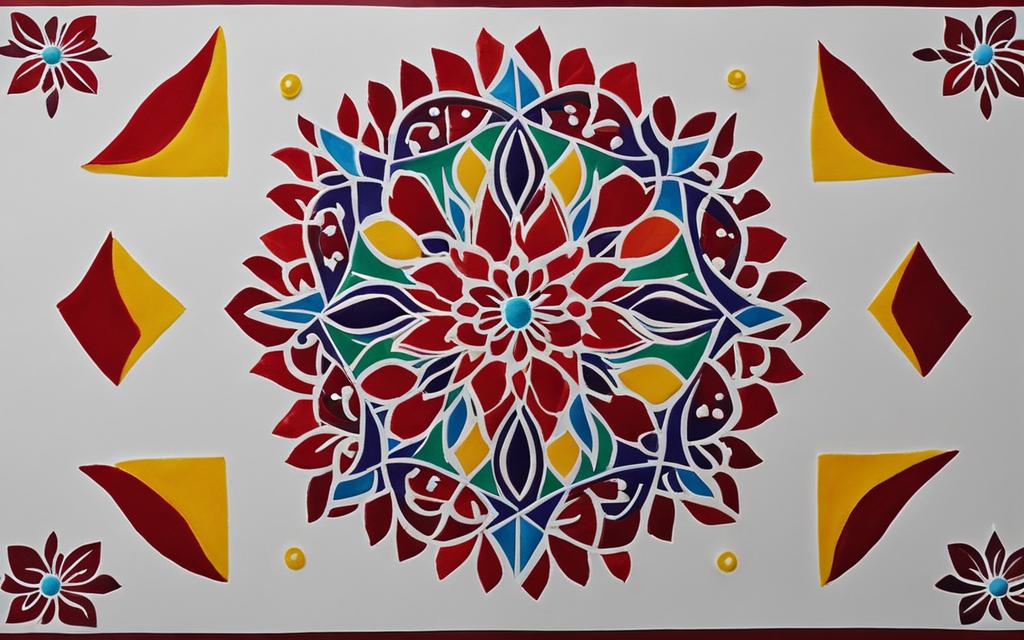
Table of Contents
- 1 What is Rangoli and Its Significance?
- 2 The Basics of Simple Rangoli Designs
- 3 Simple Rangoli Designs with Flowers
- 4 Creating Simple Rangoli Designs with Grains
- 5 Easy Steps to Make Simple Rangoli Designs
- 6 Tips and Tricks for Creating Beautiful Rangoli Designs
- 7 Simple Rangoli Designs for Different Occasions
- 8 Personalizing Simple Rangoli Designs
- 9 Showcasing Simple Rangoli Designs
- 10 Simple Rangoli Designs – A Reflection of Indian Culture
- 11 Conclusion
- 12 FAQ
- 12.1 What is Rangoli and its significance?
- 12.2 How can I create simple rangoli designs?
- 12.3 What materials can I use for simple rangoli designs?
- 12.4 How do I make simple rangoli designs with flowers?
- 12.5 How do I make simple rangoli designs with grains?
- 12.6 What are the easy steps to make simple rangoli designs?
- 12.7 Do you have any tips and tricks for creating beautiful rangoli designs?
- 12.8 Can you provide some simple rangoli designs for different occasions?
- 12.9 How can I personalize simple rangoli designs?
- 12.10 How should I showcase simple rangoli designs?
- 12.11 What do simple rangoli designs represent?
- 12.12 What is the significance of simple rangoli designs?
- 13 Source Links
Key Takeaways:
- Learn the basics of simple rangoli designs using geometric patterns and dot techniques.
- Explore the beauty of flower rangolis by creating captivating designs with fresh petals.
- Discover the art of making rangoli designs using grains and dry pulses for a unique touch.
- Follow easy steps to create your own simple rangoli designs and add personalized elements.
- Showcase your rangoli designs in prominent areas and capture their beauty through photography.
- Appreciate how simple rangoli designs reflect the rich cultural heritage of India.
What is Rangoli and Its Significance?
Rangoli is an ancient Indian art form that holds great cultural and mythological significance. It involves creating vibrant and intricate designs using dry powders or flowers.
Rangoli is usually made in front of the house or at the entrance, and it is believed to bring good luck and prosperity to the household.
This beautiful art form is deeply rooted in Indian traditions and is commonly made during festivals and special occasions.
The significance of rangoli extends beyond its decorative purpose. It is a way to beautify the surroundings and create a welcoming atmosphere for guests.
The colours used in rangoli designs reflect the diversity and vibrancy of Indian culture. The intricate patterns represent the rich heritage and creativity of the country.
Rangoli-making is also considered a form of meditation and a way to connect with the spiritual realm.
The practice of rangoli-making has been passed down through generations, with each design carrying its unique symbolism. It is a way for individuals to express their creativity and showcase their artistic skills.
Rangoli is not just a form of decoration; it is a reflection of Indian culture and a celebration of its beauty and traditions.
“Rangoli is a beautiful art form that not only adds colour and beauty to our homes but also connects us with our roots and traditions.”
The Cultural Significance of Rangoli
Rangoli holds a special place in Indian culture as it brings people together and fosters a sense of unity and harmony.
During festivals and celebrations, families and communities come together to create rangoli designs, sharing laughter, creativity, and joy. It is a way to strengthen bonds and create lasting memories.
The practice of making rangoli designs also serves as a form of storytelling. Each shape, pattern, and colour has its own significance and conveys a message or a story.
Rangoli designs are often inspired by mythological tales, folk traditions, and auspicious symbols. By creating rangoli, individuals not only express their artistic abilities but also keep alive the stories and traditions that have been passed down through generations.
Rangoli as an Expression of Hospitality
Rangoli is considered a symbol of hospitality and is used to welcome guests into homes and public spaces.
The intricate and beautiful designs create a warm and inviting atmosphere, making visitors feel valued and respected.
Rangoli is often made as a gesture of goodwill and is a way to express gratitude and appreciation for the blessings in life.
Creating rangoli designs requires patience, attention to detail, and a deep understanding of colour combinations. It is a form of art that transcends language barriers and cultural boundaries.
Rangoli-making is a cherished tradition that continues to thrive, ensuring that the beauty of Indian culture is celebrated and preserved for generations to come.
The Basics of Simple Rangoli Designs
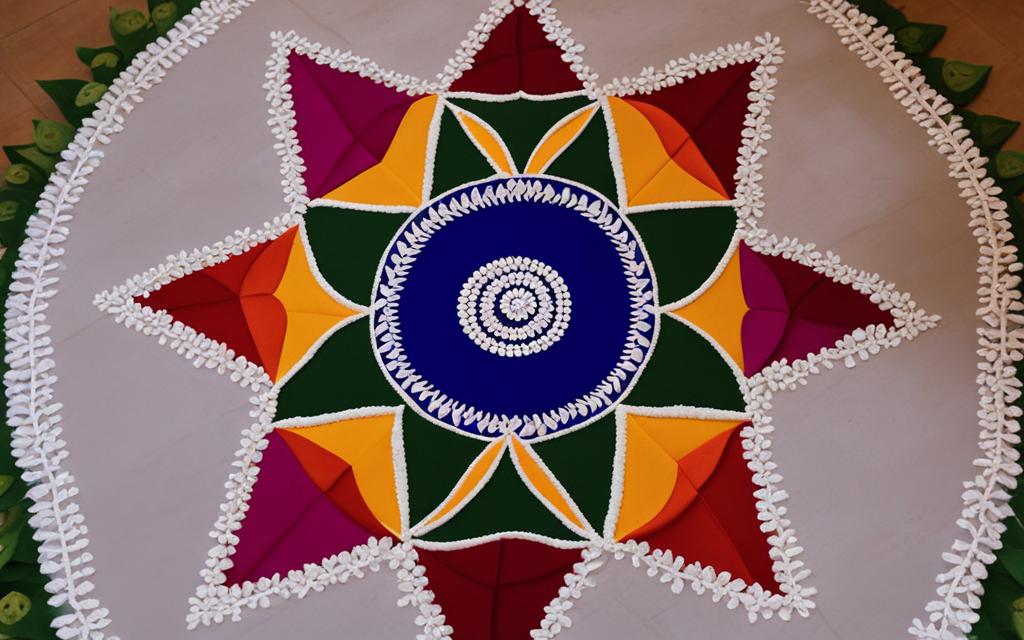
If you’re a beginner looking to master the art of simple rangoli designs, it’s important to start with the basics.
By understanding the fundamental techniques and patterns, you can gradually enhance your skills and create stunning rangoli designs. Here are some key aspects to consider when getting started:
1. Geometric Patterns
Geometric patterns are an excellent way to begin your rangoli journey. Shapes like circles, squares, and triangles are easy to create and can be filled with different colours to add visual appeal to your designs.
Experiment with different combinations and arrangements to explore the endless possibilities of geometric rangoli patterns.
2. Dots and Lines
Another simple technique for creating rangoli designs is using dots and lines. Start by placing dots in a grid-like pattern and then connect them with lines or curves to form various shapes. This method allows you to create intricate and symmetrical designs with ease.
As you gain confidence, you can increase the complexity by adding more dots and connecting them in creative ways.
3. Gradual Progression
As a beginner, it’s important to start with simpler designs and gradually progress to more intricate ones.
This allows you to build your skills and confidence over time. Begin with small-sized rangoli designs and then gradually work your way up to larger and more detailed patterns.
Remember, practice makes perfect, so don’t be afraid to experiment and learn from your mistakes.
| Advantages of Simple Rangoli Designs | Disadvantages of Simple Rangoli Designs |
|---|---|
| Easy to create | May lack complexity |
| Require minimal materials | Less room for creativity |
| Can be completed quickly | Less scope for experimentation |
Creating simple rangoli designs allows beginners to learn and understand the basic techniques involved in this ancient art form. It provides a solid foundation for developing more complex and intricate designs in the future.
By focusing on the basics, incorporating geometric shapes, mastering the use of dots and lines, and gradually progressing your skills, you’ll be well on your way to creating beautiful and captivating rangoli designs.
Remember to practice regularly and let your creativity flow as you explore the rich world of rangoli art.
Simple Rangoli Designs with Flowers
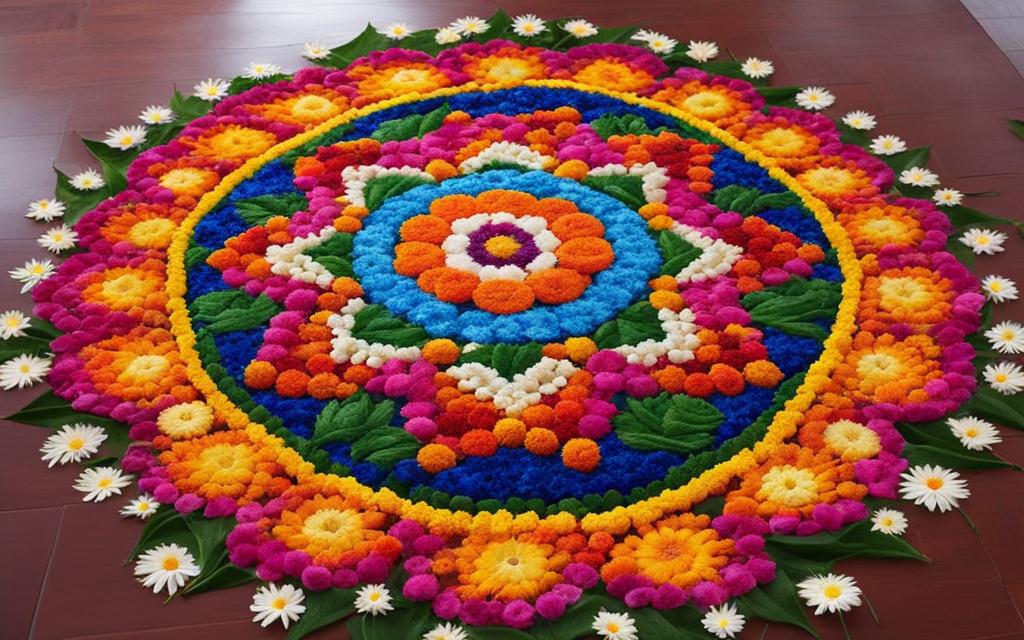
Rangoli designs with flowers are a delightful way to add natural beauty and fragrance to your home. Fresh flowers like marigolds, roses, and jasmine can be used to create stunning rangoli patterns that will instantly brighten up any space.
Whether you’re celebrating a festival or simply want to add a touch of charm to your everyday life, here are some simple rangoli designs with flowers to inspire you.
Table: Simple Rangoli Designs with Flowers
| Rangoli Design | Description |
|---|---|
| Rose Petal Swirl | Create a swirl design using rose petals in vibrant colours. Start from the center and gradually form a spiral shape, adding layers of petals. |
| Lotus Pattern | Arrange different coloured petals in the shape of a lotus flower. Add details like leaves and a center using contrasting flower petals. |
| Peacock Feathers | Use blue and green flower petals to mimic the vibrant colours of peacock feathers. Create a feather-like pattern and add a small circular design for the body. |
| Flower Mandala | Arrange flowers in intricate patterns to create a Mandala-inspired rangoli design. Use a variety of flowers and colours to add depth and complexity. |
These simple rangoli designs with flowers can be created with ease and are perfect for beginners. The natural colours and fragrances of the flowers will bring a sense of joy and positivity to your home.
Experiment with different flower combinations and get creative with your designs. Let your imagination bloom and enjoy the process of creating these beautiful floral rangoli patterns.
Remember to choose flowers that are readily available in your area and consider the size of your rangoli space.
You can also add additional elements like diyas (oil lamps) or small decorative items to enhance the overall aesthetic.
Admire the beauty of your creation and share it with your loved ones, celebrating the art of rangoli and the vibrant spirit of Indian culture.
Get inspired by the beauty of nature and explore the endless possibilities of creating simple rangoli designs with flowers.
Let the colours and fragrance of these floral creations fill your home with joy and positivity. Embrace the art form of rangoli and let your creativity blossom.
Creating Simple Rangoli Designs with Grains
Creating rangoli designs using grains and dry pulses is a unique and eco-friendly way to add a touch of creativity to your home.
Beans, rice, wheat, and lentils can be transformed into beautiful and intricate patterns, making your rangoli design stand out. Let’s explore the process of creating simple rangoli designs with grains and discover the endless possibilities.
When creating rangoli designs with grains, you can use different types and colours of beans, such as black-eyed peas, red kidney beans, or green lentils, to add variety and depth to your design.
You can also mix different grains together to create a visually appealing texture. The grains can be left in their natural colour, or you can dye them using natural food colouring to match your desired colour scheme.
To create a grain rangoli, start by outlining the design on the floor or surface using a chalk or pencil.
Then, carefully fill in the design with your chosen grains, making sure to follow the outline. You can use a glue stick or adhesive to secure the grains in place, especially if you want the rangoli to last longer.
Once the rangoli is complete, it’s ready to be displayed and admired by your guests.
Creating simple rangoli designs with grains is not only a creative activity but also a mindful and eco-friendly way to connect with Indian traditions.
You can experiment with different types of grains, colours, and patterns to personalize your rangoli designs and make them truly unique.
So, gather your grains, unleash your creativity, and let the beauty of grain rangolis adorn your home.
Easy Steps to Make Simple Rangoli Designs
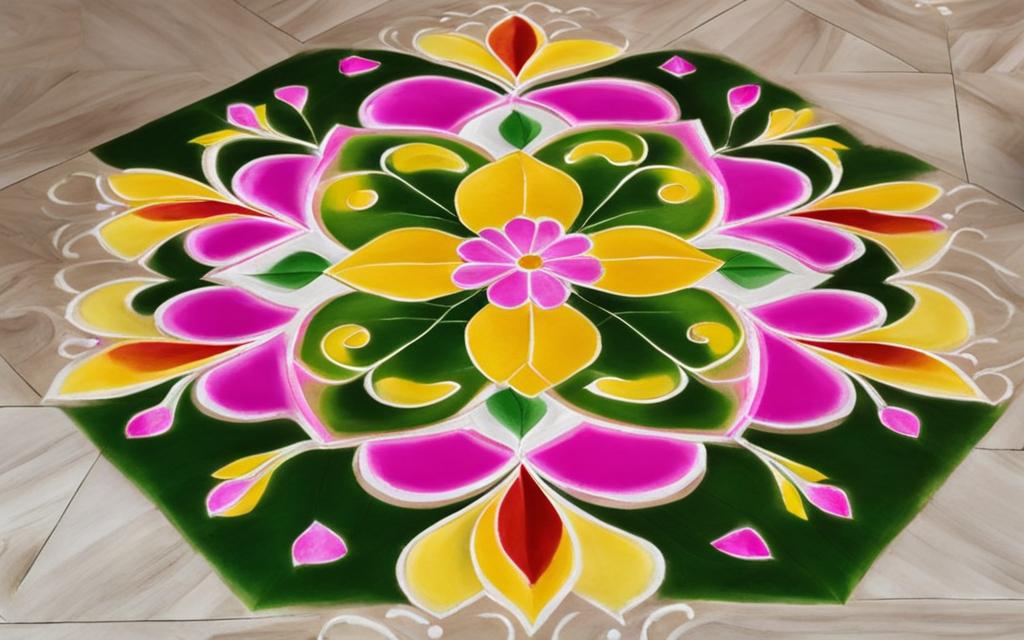
Creating beautiful rangoli designs is a creative and enjoyable activity that allows you to showcase your artistic skills.
By following these easy steps, you can make stunning rangoli designs that will impress everyone. Let’s dive into the process:
Gather Your Materials
Before you start creating your rangoli design, ensure that you have all the necessary materials. Depending on your preference, you can use coloured powders, flowers, or grains.
Make sure you have enough quantity of your chosen material to complete the design.
Clean the Surface
Prepare the surface where you will be making the rangoli. Sweep away any dust or debris and make sure the area is clean and dry.
This will provide a smooth canvas for your design and enhance its overall appearance.
Outline Your Design
Using a pencil or chalk, lightly draw an outline of the design you want to create. This will serve as a guide while filling in the colours or arrangement. You can choose geometric shapes, floral patterns, or any other design that inspires you.
Fill in the Design
Once you have the outline, begin filling in the design with your chosen materials. Take your time and carefully follow the pattern, ensuring that the colours or arrangement are neat and precise.
You can experiment with different colour combinations or textures to make your design truly unique.
Add Details and Embellishments
To enhance your rangoli design further, consider adding small details and embellishments. You can use contrasting colours, beads, sequins, or mirrors to create highlights and texture.
These elements will add depth and visual interest to your design.
Once you have completed your rangoli design, allow it to dry or set before displaying it. Admire your creation and share it with others to spread the beauty of this traditional Indian art form.
| Easy Steps to Make Simple Rangoli Designs |
|---|
| Gather Your Materials |
| Clean the Surface |
| Outline Your Design |
| Fill in the Design |
| Add Details and Embellishments |
Tips and Tricks for Creating Beautiful Rangoli Designs
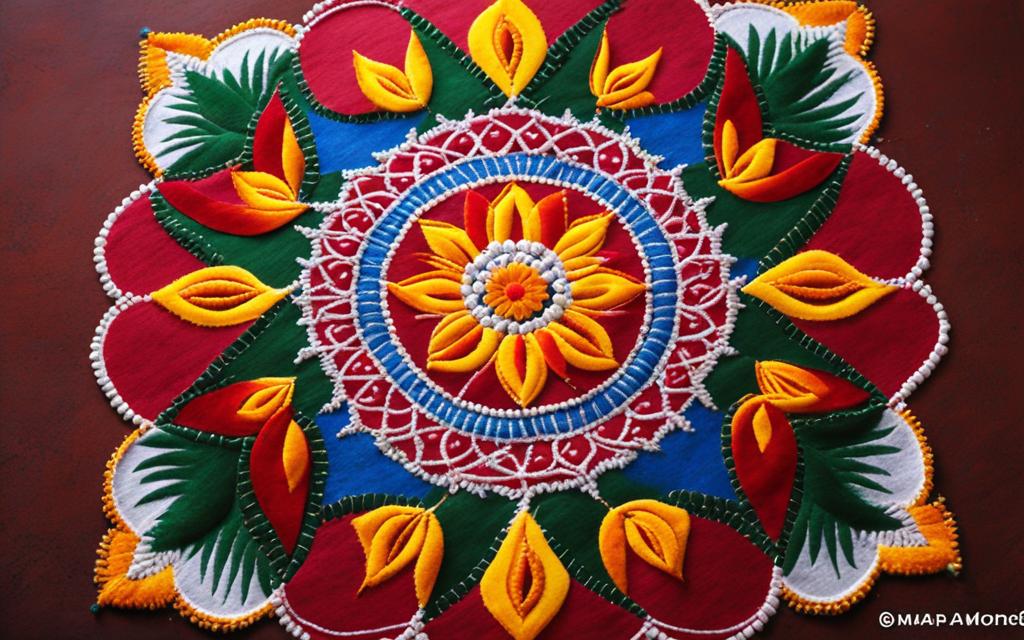
Creating beautiful rangoli designs is a delightful and creative process. To help you enhance your skills and create stunning designs, here are some valuable tips and tricks:
1. Practice Makes Perfect
Mastering rangoli design requires practice and patience. Spend some time each day practicing basic shapes and patterns. By doing so, you’ll improve your skills and gain confidence in creating intricate designs.
2. Use Contrasting colours
To make your rangoli designs visually appealing, choose colours that create a striking contrast against the background.
For example, if the floor is light-coloured, opt for vibrant and darker shades. This contrast will make your design stand out and grab attention.
3. Add Embellishments
To make your rangoli designs even more captivating, consider using embellishments such as beads, sequins, or mirrors.
These decorative elements will add sparkle and texture to your design, making it more visually appealing.
4. Experiment with Different Materials
While traditional rangoli designs are made with powders, flowers, or grains, don’t be afraid to experiment with unconventional materials. coloured salt, sand, or even spices like turmeric or chili powder can be used to create unique effects and add a touch of creativity to your designs.
5. Take Inspiration from Nature
Nature is an abundant source of inspiration for rangoli designs. Incorporate elements such as flowers, leaves, or peacock feathers into your designs to add a natural touch.
These elements not only enhance the beauty of the design but also evoke a sense of harmony with the surroundings.
6. Take Help from Online Tutorials
If you’re feeling stuck or need guidance while creating rangoli designs, online tutorials can be a valuable resource.
Many video tutorials provide step-by-step instructions and tips from experienced artists. These tutorials will inspire and help you explore new techniques and designs.
By following these tips and tricks, you’ll be able to create beautiful rangoli designs that showcase your creativity and reflect the vibrant spirit of this traditional Indian art form.
| Materials | Advantages | Disadvantages |
|---|---|---|
| Powders | – Wide range of colours available – Easy to create intricate patterns |
– Powders may blow away or get smudged – Not suitable for outdoor designs during windy weather |
| Flowers | – Adds natural beauty and fragrance – Easy to create visually appealing designs |
– Requires fresh flowers, which may not be available at all times – Designs may not last long |
| Grains | – Eco-friendly and sustainable option – Easily available and affordable |
– Limited range of colours available – Designs may not be as vibrant as with powders or flowers |
| Unconventional Materials | – Allows for unique and creative effects – Can create texture and depth in the design |
– May not be readily available – Requires experimentation to achieve desired results |
Remember, practice, creativity, and experimentation are key to creating beautiful rangoli designs. Enjoy the process and let your imagination soar as you express yourself through this ancient art form.
Simple Rangoli Designs for Different Occasions
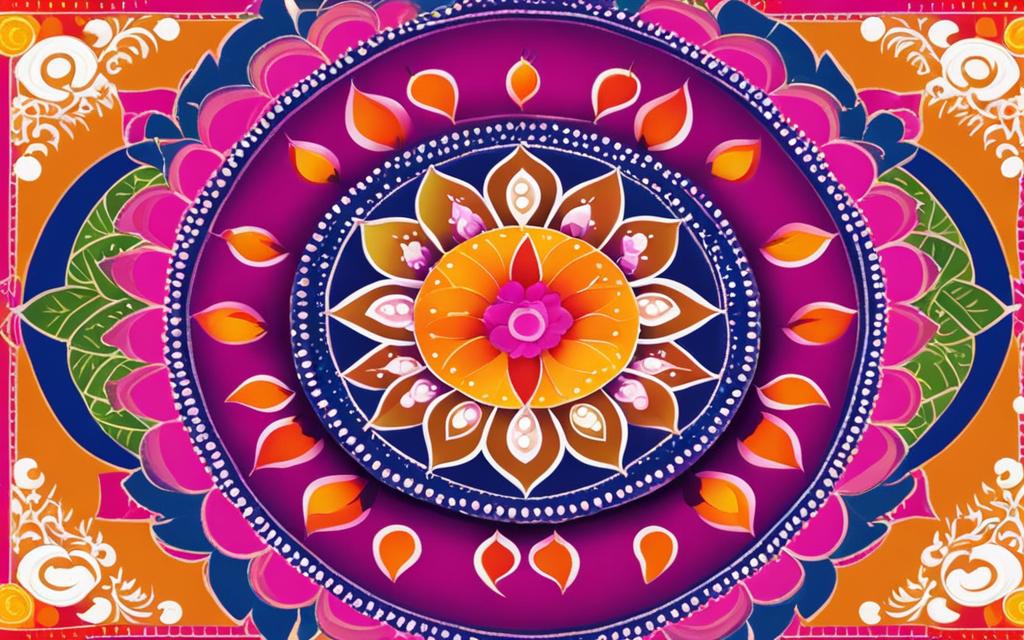
When it comes to creating beautiful rangoli designs, it’s important to consider the occasion or theme you want to celebrate. Here are some ideas for simple rangoli designs for different occasions:
Diwali
Diwali, also known as the festival of lights, is a perfect time to showcase your creativity with rangoli designs.
Create rangoli designs with diyas (oil lamps) to symbolize the triumph of light over darkness. You can incorporate traditional motifs like lotus flowers, peacocks, and diyas in vibrant colours to make your rangoli stand out.
A centerpiece with a diya surrounded by intricate patterns will add a touch of elegance to your Diwali celebrations.
Wedding
Rangoli designs are a beautiful way to decorate the venue for a wedding ceremony. You can create rangoli patterns in the shape of a mandap (wedding altar) to add a traditional touch.
Use vibrant colours like red, yellow, and orange to symbolize joy and celebration. Incorporate floral designs or motifs like the bride and groom’s initials to personalize the rangoli and make it unique to the couple’s special day.
Navratri is a festival dedicated to the worship of Goddess Durga, and it is celebrated with dance and music. Create rangoli designs inspired by Garba, the traditional dance form of Gujarat, by incorporating swirling patterns and vibrant colours.
You can also create a rangoli pattern using nine different colours to represent the nine forms of Goddess Durga. This will add a festive and auspicious touch to your Navratri celebrations.
Holi
Holi, also known as the festival of colours, is a vibrant and colourful celebration. Create colourful rangoli designs using powdered dyes or gulal to reflect the spirit of Holi.
Use a variety of bright colours like pink, yellow, green, and blue to create a playful and joyful ambience. Incorporate patterns like splashes, handprints, or abstract shapes to capture the essence of Holi and spread the joy of colours.
Pongal
Pongal is a harvest festival celebrated in South India, and rangoli designs play a significant role in the festivities. Create rangoli designs with rice flour to symbolize abundance and prosperity.
Decorate the rangoli with sugarcanes, which are an integral part of Pongal celebrations. You can also incorporate motifs like the sun, cows, and farming tools to represent the agricultural significance of the festival.
Whether it’s Diwali, a wedding, Navratri, Holi, or Pongal, simple rangoli designs can add a touch of beauty and tradition to your celebrations.
Explore different patterns, colours, and themes to create unique and eye-catching rangoli designs that reflect the spirit of the occasion.
Personalizing Simple Rangoli Designs
When it comes to simple rangoli designs, adding a personal touch can make them even more special. By personalizing your rangoli, you can create designs that reflect your unique personality, interests, and commemorations.
Whether it’s incorporating initials or names of loved ones, representing your hobbies or passions, or using symbols that hold significance to you, personalization adds an extra layer of meaning to your rangoli creations.
One way to personalize your rangoli designs is by incorporating initials or names. You can spell out the names of your family members or loved ones in a beautiful font, or even create a monogram using their initials.
This not only adds a personal touch but also makes the rangoli design a wonderful tribute to your relationships and the people who matter most to you.
Another way to personalize your rangoli designs is by incorporating elements that represent your hobbies or interests.
If you’re a nature lover, you can include motifs of flowers, birds, or trees in your design. For those passionate about music, you can create rangoli patterns inspired by musical notes or instruments.
Adding these personal elements not only showcases your interests but also allows you to express yourself creatively through your rangoli art.
Lastly, using symbols that hold significance to you can make your rangoli designs truly unique. Consider incorporating symbols that represent your cultural or religious beliefs, such as om or swastika patterns.
You can also incorporate symbols of good fortune or prosperity, like the lotus or the peacock. These symbols not only add a deeper meaning to your rangoli designs but also create a sense of connection and spirituality.
Showcasing Simple Rangoli Designs
Now that you have created your beautiful simple rangoli designs, it’s time to showcase them in the best way possible.
Placing your rangoli designs in a prominent place, such as at the entrance of your home or in a central area, will ensure that they are easily seen and appreciated by all. You can also use lighting techniques to highlight the designs and create an eye-catching display.
By properly showcasing your rangoli designs, you can share their beauty and significance with your friends and family.
Remember to take photographs of your rangoli designs, capturing their intricate patterns and vibrant colours.
These photographs will serve as lasting memories of your creative artwork. You can share these photographs on social media or create a photo album to document your rangoli-making journey.
“Rangoli designs are a true representation of the rich cultural heritage of India. By showcasing your simple rangoli designs, you are not only celebrating the beauty of this art form but also sharing a piece of Indian culture with the world.”
So, go ahead and proudly display your simple rangoli designs. Let them brighten up your home and inspire others to appreciate the beauty of this traditional Indian art form.
| Occasion | Idea |
|---|---|
| Diwali | Create rangoli designs with diyas to celebrate the festival of lights. |
| Wedding | Design rangoli patterns in the shape of a mandap or use floral designs to decorate the wedding venue. |
| Navratri | Make rangoli designs inspired by Garba dance or use vibrant colours to represent the nine forms of Goddess Durga. |
| Holi | Create colourful rangoli designs using powdered dyes or gulal to celebrate the festival of colours. |
| Pongal | Make rangoli designs with rice flour and decorate them with sugarcanes to celebrate the harvest festival. |
Simple Rangoli Designs – A Reflection of Indian Culture
Creating simple rangoli designs is not just a form of decoration; it is a way to celebrate and reflect the rich heritage and cultural traditions of India.
The art of rangoli making has been passed down from generation to generation, carrying with it the creativity and spiritual beliefs of the country.
Each design holds its unique symbolism, making it a meaningful representation of Indian culture.
Rangoli designs beautifully showcase the diversity and beauty of India. From geometric patterns to floral motifs, each design tells a story and represents different aspects of Indian life.
The vibrant colours and intricate details of rangoli designs reflect the artistic skills and craftsmanship of the people.
Additionally, rangoli making is not just a decorative practice; it holds great significance in various festivals and occasions. It is believed to bring good luck, ward off evil spirits, and create a welcoming environment for guests.
The process of creating a rangoli involves concentration, precision, and patience, making it a meditative and therapeutic art form.
By embracing and creating simple rangoli designs, we can connect with our roots and keep the traditions alive. It is a way to honor our cultural heritage and showcase the beauty of Indian artistry.
So, let’s immerse ourselves in the world of rangoli and appreciate the essence of Indian culture through this mesmerizing art form.
Rangoli Designs: A Glimpse into Indian Culture
“Rangoli is not just an art form; it is a reflection of the colours, traditions, and spirituality that define Indian culture.” – Unknown
Rangoli designs are more than just colourful patterns made on the ground; they are a window into the heart of Indian culture.
Each design carries its significance, representing various aspects of Indian life, from mythology and spirituality to nature and festivities.
During festivals like Diwali, Pongal, and Navratri, rangoli designs adorn the entrance of homes, welcoming prosperity and good fortune.
They serve as a symbol of unity, as families come together to create these beautiful designs, passing down the art form from one generation to another.
The use of vibrant colours and intricate patterns in rangoli designs reflects the diversity and richness of Indian traditions.
From geometric shapes to floral motifs, each design showcases the artistic skills and creativity of the people. It is a form of expression that transcends language barriers and brings people together in celebration.
The Symbolism of Rangoli Designs
Rangoli designs hold deep symbolism in Indian culture. The choice of colours, patterns, and motifs represents different aspects of life and spirituality.
For example, a lotus flower design signifies purity and enlightenment, while a peacock design represents beauty and grace.
Furthermore, rangoli designs often incorporate elements from nature, such as flowers, leaves, and birds, reflecting the close connection between humans and the environment.
They serve as a reminder of our responsibility to protect and cherish the natural world.
In conclusion, simple rangoli designs are much more than just patterns made on the ground. They are a reflection of Indian culture, traditions, and values.
By practicing and embracing this ancient art form, we not only celebrate our heritage but also keep the spirit of Indian culture alive for generations to come.
Conclusion
In conclusion, mastering the art of simple rangoli design is a delightful journey that allows you to embrace Indian culture and showcase your creativity. By following the easy steps and exploring creative ideas, you can create stunning rangoli designs that bring colour and beauty to your home.
Simple rangoli designs are more than just decorative patterns; they are an embodiment of the rich heritage, spiritual beliefs, and artistic prowess of India. With each design, you connect with your roots and celebrate the beauty of Indian culture.
So, gather your materials, let your imagination soar, and start creating beautiful rangoli designs that will captivate everyone’s attention. Whether it’s during festivals or special occasions, your unique rangoli creations will leave a lasting impression and add a touch of vibrancy to the ambiance.
>> Please look at my other posts:
FAQ
What is Rangoli and its significance?
Rangoli is a traditional Indian art form that involves creating colourful designs using dry powders or flowers. It has deep cultural and mythological significance and is usually made during Indian festivals and special occasions. Rangoli is believed to bring good luck and prosperity to the household.
How can I create simple rangoli designs?
To create simple rangoli designs, start with geometric patterns like circles, squares, and triangles. You can also use dots to form shapes and patterns. Gradually increase the size and complexity of the rangoli as you gain expertise. You can also try using flowers or grains to create unique designs.
What materials can I use for simple rangoli designs?
You can use dry powders, flowers, grains, or even unconventional materials like coloured salt or sand for simple rangoli designs.
How do I make simple rangoli designs with flowers?
Use fresh flowers like marigolds, roses, and jasmine to create beautiful and fragrant rangoli designs. Arrange the petals in intricate patterns or form larger shapes like lotus or peacock.
How do I make simple rangoli designs with grains?
Use beans, rice, wheat, or lentils to create unique rangoli patterns with grains. These materials are easily available and can be coloured or arranged to form interesting designs.
What are the easy steps to make simple rangoli designs?
1. Choose a design or pattern you want to create. 2. Prepare the materials you will need. 3. Clean the surface where you will make the rangoli. 4. Make an outline of the design. 5. Fill in the design with your chosen materials. 6. Add details and embellishments. 7. Allow the rangoli to dry or set before displaying it.
Do you have any tips and tricks for creating beautiful rangoli designs?
Yes. Here are some tips: practice basic shapes and patterns, use contrasting colours, add embellishments like beads or sequins, experiment with different materials, take inspiration from nature, and watch online tutorials for guidance.
Can you provide some simple rangoli designs for different occasions?
Sure. Here are some ideas: Diwali – rangoli designs with diyas, Wedding – mandap-shaped or floral designs, Navratri – Garba dance-inspired or nine forms of Durga representation, Holi – colourful designs using powdered dyes, Pongal – rice flour designs decorated with sugarcanes.
How can I personalize simple rangoli designs?
You can add initials or names of family members, incorporate designs that represent your hobbies or interests, or use symbols that are significant to you to make the rangoli designs more personal and unique.
How should I showcase simple rangoli designs?
Place them in a prominent place at the entrance of your home or in a central area where they can be easily seen. Use lighting techniques to highlight the design and create an eye-catching display. You can also take photographs to capture the beauty of your rangoli designs and share them with others.
What do simple rangoli designs represent?
Simple rangoli designs are a reflection of Indian culture. They represent the rich heritage, creativity, and spiritual beliefs of the country. Rangoli making is a tradition passed down through generations, with each design carrying its unique symbolism.
What is the significance of simple rangoli designs?
Simple rangoli designs are not just a form of decoration but also a way to connect with Indian traditions and celebrate the beauty of Indian culture. They add colour and beauty to homes and are believed to bring good luck and prosperity.
